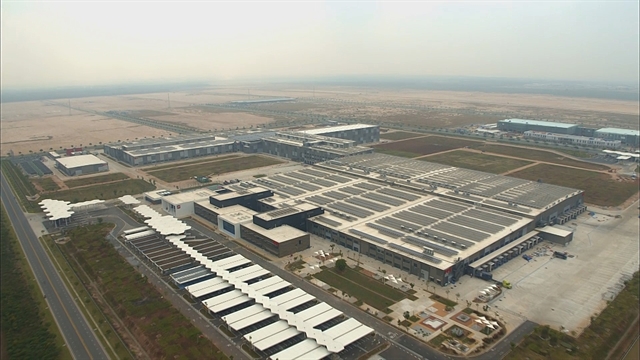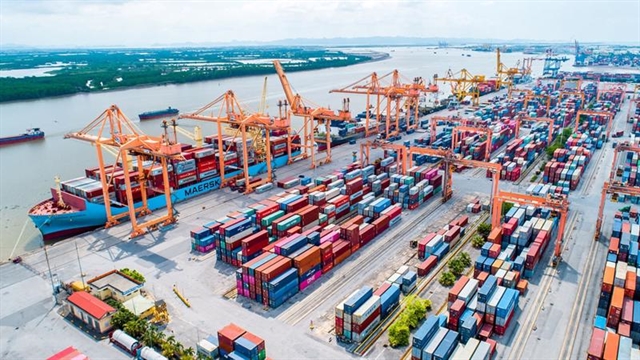 Economy
Economy

 |
| Hải Phòng port cluster in Hải Phòng City. In 2023, the business activities of the entire seaport industry were weak due to declining external demand, especially from key export markets such as the United States and Europe. — VNA/VNS Photo |
HÀ NỘI — Cargo throughput of deep-water ports in 2024 is expected to double compared to transshipment ports, while the capacity of seaports remains unchanged. This is expected to have a positive impact on the profits of businesses that own deep-water ports.
In 2023, the business activities of the entire seaport industry were weak due to declining external demand, especially from key export markets such as the United States and Europe.
According to the General Statistics Office, Việt Nam's total import-export turnover in 2023 was estimated at US$683 billion, a 6.6 per cent decrease compared to 2022. Specifically, exports decreased by 4.4 per cent and imports decreased by 8.9 per cent. The significant decline in import turnover indicates that manufacturing enterprises are not yet witnessing a vibrant recovery in short-term order prospects.
Several major seaports also reported limited cargo volume for about 1-2 months, as shipping lines did not commit to long-term volume agreements (6-12 months) as was customary in previous years.
In terms of volume, the seaport industry recorded less negative results, especially in the second half of 2023. According to data from the Việt Nam Maritime Administration (Vinamarine), total container throughput in Việt Nam in the first 11 months of 2023 decreased by only 1 per cent compared to the same period in 2022, reaching 22.6 million TEUs. Particularly in the northern region, the throughput of the Hải Phòng port cluster decreased by only 1 per cent in the first 11 months of 2023, reaching 5.7 million TEUs.
According to analysts at SSI Research, there have been clear signs of improvement in throughput at the Hải Phòng port cluster since mid-2023. This is attributed to the fact that these ports are less reliant on shipping routes to the United States and Europe compared to ports in the southern region, with higher contribution from the intra-Asia market, such as China, Japan and South Korea, as well as countries with more relaxed monetary policies than the US and Europe, resulting in less robust inventory destocking activities.
The average freight rates at Vietnamese seaports remained stable in 2023. However, the after-tax profits of listed parent companies in the seaport industry decreased by 4 per cent in the first three quarters of 2023 compared to the same period in 2022, mainly due to the decline in throughput.
Regarding business outlook for the seaport industry in 2024, analysts at SSI Research evaluate that throughput will recover due to improving import-export demand, particularly as the US and European markets replenish their inventories.
Based on SSI Research's baseline scenario, the US economy will not experience a recession or a hard landing, but will have slower growth, and retail businesses will ramp up inventory restocking after a 1.5-year inventory reduction period. The next interest rate cut by the US Federal Reserve will be another supportive factor for consumer spending and production. All these factors will contribute to an increase in the volume of goods transported by sea and handled at Vietnamese ports.
The forecast for Việt Nam's import-export turnover in 2024 is 10 per cent growth, and the volume of goods (measured in TEU – twenty-foot equivalent unit container capacity) in the entire industry is also expected to increase by 10 per cent compared to 2023. The growth rate may be stronger in the first half of 2024 due to the low base in 2023.
Notably, SSI Research states, "We believe that the volume growth may be higher for deep-water ports, with a growth rate of 15 per cent compared to the same period in 2023, thanks to increased activities with the US and European markets, compared to a growth rate of only 7 per cent at transshipment ports, which primarily serve the intra-Asia market."
Therefore, this will benefit companies that own deep-water ports such as Gemadept Corporation (GMD) and Việt Nam Maritime Corporation (MVN).
Indeed, in terms of supply, the capacity of seaports does not undergo significant changes until 2025 when several large deep-water ports become operational. These include Lạch Huyện 3&4 by Hải Phòng Port Corporation (PHP), Lạch Huyện 5&6 by Hateco Group, Gemalink 2A, and Nam Đình Vũ 3 by Gemadept, with a total capacity of 3.3 million TEUs, equivalent to 12 per cent of Việt Nam's port container throughput in 2023.
The profitability of seaport enterprises is partially supported by Circular 39/2023/TT-BGTVT issued by the Ministry of Transport, which takes effect on February 15, 2024, introducing new tariff regulations for container handling services at seaports and other services for all Vietnamese seaports.
This is an anticipated move for all businesses and investors in the industry, aiming to increase the floor price for container handling services by around 10 per cent for both transshipment ports and deep-water ports compared to previous rates.
SSI Research evaluates that this will be a supportive factor for the industry, especially for high-capacity seaports located in less competitive positions (such as Lạch Huyện and Cái Mép deep-water port areas). — VNS




